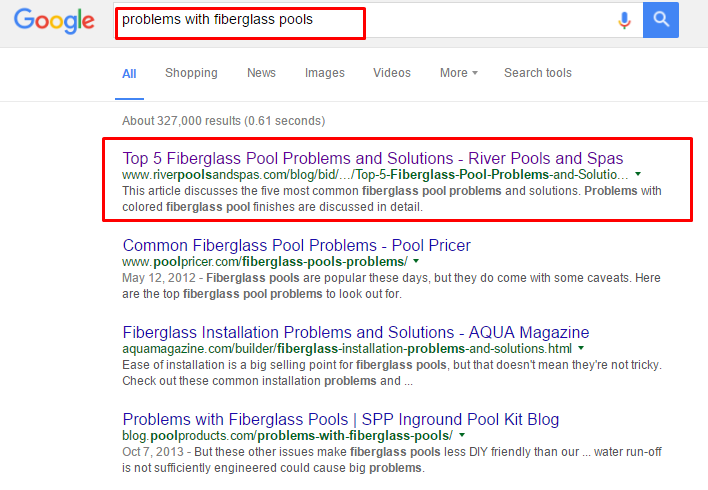
Back in the day when I was just a newbie digital marketer, one of the first influencers I became aware of and started following was Marcus Sheridan. His style was down to earth and his story was inspiring. By simply creating content that answered common questions that potential customers asked, Marcus saved his pool company from the brink of extinction and made it the most trafficked swimming pool website IN THE WORLD!
It’s so simple. Answer the questions that people are probably already searching for on the search engines. Then you get ranked in the search engines AND establish yourself as an expert in your field, giving potential customers a reason to buy from YOU rather than your competitor.
So that was eight years ago. Surely EVERYONE is employing this technique now, right?
WRONG!
We still see so many companies posting self-promotional material or just failing to blog at all because they have no idea what to write.
YES, really! But that ends now. I’m going to tell you how to employ this technique to make your blog the most authoritative and valuable resource in your industry.
Which questions?
If you compiled all the questions your customers and prospects have floating around their pretty little heads about your product or service, you could probably fill up your editorial calendar for a whole year. Really? Yes, really (OK, I’ll stop now).
The key is figuring out what questions they have. But actually, that is quite simple, too. Here are a few ways:
- Talk to your sales and customer service teams. This is the easiest, and probably most effective, ways to suss out the issues your audience is struggling with. Everyday, these team members are fielding real live questions that you already know your audience needs and wants the answers to. What better fodder for blog posts?
- Surveys. You can take it a step further and send surveys out to your email list (you do have one, right?) to find out what burning questions they have been holding back.
- Forums. Is there a place your audience congregates to discuss interests related to your product or service? Troll those areas to find questions that could be answered via your blog. For instance, say you sell snowmobile gear and you see a question in a forum asking which is better, motocross or full face helmets. You could do an article listing the pros and cons of each. As a bonus, these forums give you insight into what language your audience uses to refer to your product. Quora is another place to try, especially if you can’t find any industry-specific forums in your niche.
- Competitors. While you never want to copy your competitor, a glance at their Frequently Asked Questions can give you additional ideas. Chances are, they’ve only provided a surface answer, while you could create a killer blog article that would address the issue in-depth.
You have your questions. Now What?
Now you write articles that answer the questions you uncovered. The good news is, most of the knowledge you need to do that is already in your head (or in a head somewhere in your company). All you have to do is extract that knowlege and get it into a blog post.
Your goal should be to write the most authoritative piece answering that question on the internet. Go back to your keyword research to uncover the words your audience uses to refer to the topic and to find all of the terms that might relate to this specific question. Write a thorough post that addresses all of the nuances of the issue.
Think about the format of your post. Don’t be afraid to mix it up with different formats and post types to best address the issue. Would the post be best presented in a list format? Or maybe it should include an explainer video. Certainly, screenshots and other visuals that help prove or illustrate your points should always be considered.
Above all, keep it simple. While the post should be authoritative and as long as necessary to sufficiently answer the question, the content itself should be jargon-free and again, written in the language your audience uses. Be careful with these posts not to be too clever, especially with the title. If the question you’re trying to answer is “What is the best schlond poofa for my pink convertible?” your title should be “The 5 Best Schlond Poofa’s” or something like that. (Please forgive the Barbie reference. I have two little girls.)
Be Brave
Some of the questions you uncover may be ones you don’t want to answer.
- How does it cost?
- What are the potential problems with your product?
- How does your product compare with a competitors’?
As hard as it may seem, don’t shy away from those questions. And answer them honestly. Consider this article from Marcus Sheridan’s company River Pools and Spas where the company addressed the problems with fiberglass pools. Did we mention that fiberglass pools are what they build? Isn’t this shooting themselves in the foot?
No. For one, there are tons of searches on problems and issues with fiberglass pools. And guess who comes up in those searches?

Now they are not only getting the traffic, but they get to control the conversation. That doesn’t mean they aren’t being honest. The article honestly addresses the issues but also presents the benefits, giving the audience a chance to decide for themselves. The ones who are pursuaded away from buying a fiberglass pool would have been unsatisfied customers anway, so this is really a win-win.
Promote, Promote, Promote
As with any piece of content, you need to promote these posts to get the most out of them. Another awesome thing about these pieces is that they tend to be evergreen. They’ll likely be relevant a few months or even several years from now. Therefore, you want to do more than just put out a few social media posts right after it’s published. Consider keeping a spreadsheet or list of these question-answering posts so that you can go back and share them after the initial push.
Also, consider posting these types of articles in places you may not normally engage. Quora is a big one. See if anyone on Quora has asked the question your post addresses. If so, answer that question and link back to your article. LinkedIn Groups are another great place to post these because they are inherently valuable as opposed to being self-promotional.
So Answer Those Questions, Already!
Answering customer questions is one of the easiest and effective blog writing techniques out there. Answering questions not only helps you rank better in the search engines but helps establish you as the go-to source for your product or service. Even if your visitors aren’t ready to buy now, when they are, chances are they will pick the company that provided complete and HONEST answers to their questions. Will that company be you?
Checklist for Writing Blogs That Answer Customer Questions
- Develop a list of questions by talking to your own team, sending surveys, looking at forums, and looking at competitor websites.
- Write authoritative blog posts answering those questions. Don’t forget to use keyword research to use the lanugage your customers do.
- Add media (images, video, etc.) to help clarify your points.
- Utilize good on-page SEO to help these pieces get seen on search engines.
- Promote on social media, remembering to schedule social media posts for the future as well.

2 Responses to Really?!? You’re STILL Not Using This Amazingly Simple and Effective Blog Idea?